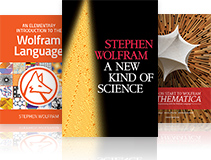Rendering Solid Models with the Aid of 3D Printers
O. Michael Melko
Published December 22, 2010
3D printers are a potentially useful tool for geometric visualization in mathematical research and education. In this article, we describe the mathematics of minimal surfaces in some detail, and then we present a Mathematica package for generating solid model data of such surfaces. In particular, we show how the package was used to generate a 3D model of Costa’s surface. Read More »
Elsevier Academic Press, 2009
ISBN 978-0-12-374164-6
Robert M. Lurie
Published November 29, 2010
Mathematica Navigator: Mathematics, Statistics, and Graphics, 3rd edition, is an important resource for all users of Mathematica, Version 6 or 7. This reviewer has found the book to be invaluable in using and understanding Mathematica and taking advantage of the many advances in the most recent versions of the program. Read More »
Pedro P. B. de Oliveira
Published September 20, 2010
DRIMA is a simple cellular model for the multi-agent setting in which reactive agents have their behavior changed by the behavior of others, as the outcome of their interactions; it is also the system that implements the model in Mathematica. It was conceived as a metaphor for the high-level issue of how agents “attract” others toward them, be it in the form of a change in any behavioral or conceptual orientation, habit, thinking, etc. This is modeled through a single behavior of the agents, which is their movement on a two-dimensional grid; as they move, they undergo interactions with each other that modify the way they move before and after the interaction. The focus of the model is on addressing issues related to the emergent dynamics of a particular setting, much in tune with an artificial life or complex systems perspective. DRIMA is purposefully meant to be simple and non-general, a minimal system for the kind of question it is designed to help address. The article is a presentation of the model and of key aspects of its implementation, not a discussion on its use to address any particular question. Read More »
Timothy I. Matis, Ivan G. Guardiola
Published September 20, 2010
In this article, we introduce the package Moment Closure, which may be used to generate closure differential equations and closure approximations of the cumulants (moments) of a nonlinear stochastic compartmental model with Markov transitions. Specifically, this package defines the pair of functions MomentClosureSystem and MomentClosurePlots that achieves moment closure through the neglect of high-order cumulants. We demonstrate the application of these functions through the analysis of several test models. In select cases, the resulting cumulant approximations are compared across neglect levels and to exact answers. Read More »
Alfonso F. Agnew, Alexandru Bobe, Wladimir G. Boskoff, Bogdan D. Suceava
Published September 20, 2010
Tzitzeica curves and surfaces represent early examples of affine-invariant geometrical objects. At the time Gheorghe Tzitzeica was studying these objects, affine differential geometry (ADG) was in its infancy. ADG was motivated by Felix Klein’s influential Erlangen program, where a geometry was defined by its set of invariants under a group of symmetries. We find that the issue lends itself well to a relatively elementary discussion suitable for upper-division undergraduates and nonspecialists, while still providing the basic thrust of this elegant subject. Moreover, the topic is an excellent one to illustrate the utility of Mathematica‘s symbolic manipulation and graphics capabilities. For this reason, the article nicely complements the existing literature on the uses of software in differential geometry (such as [1]), and it provides material that would be useful for inclusion in a differential geometry course either as an application or a project. Read More »
Phillip M. Yelland
Published September 20, 2010
Cross tabulations (also known as cross tabs, or contingency tables) often arise in data analysis, whenever data can be placed into two distinct sets of categories. In market research, for example, we might categorize purchases of a range of products made at selected locations; or in medical testing, we might record adverse drug reactions according to symptoms and whether the patient received the standard or placebo treatment.
The statistical technique presented in this article, correspondence analysis, provides a means of graphically representing the structure of cross tabulations so as to shed light on the underlying mechanisms. The article provides a practical introduction to correspondence analysis in the form of a “five-finger exercise” in textual analysis—identifying the author of a text given samples of the works of likely candidates. Read More »






